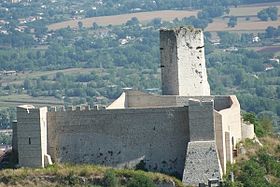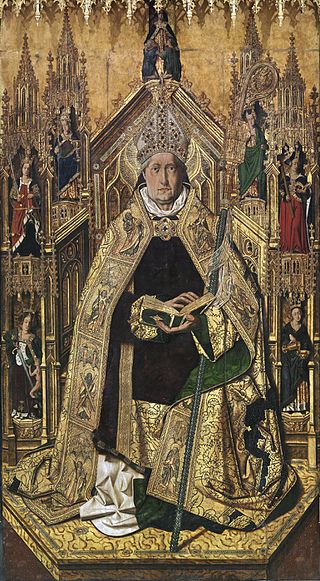
Abbot is an ecclesiastical title given to the head of an independent monastery for men in various Western Christian traditions. The name is derived from abba, the Syriac form of the Hebrew ab, and means "father". The female equivalent is abbess.
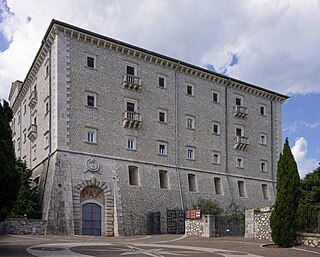
Monte Cassino is a rocky hill about 130 kilometres (80 mi) southeast of Rome, in the Latin Valley, Italy, 2 kilometres west of Cassino and at an elevation of 520 m (1,710 ft). Site of the Roman town of Casinum, it is widely known for its abbey, the first house of the Benedictine Order, having been established by Benedict of Nursia himself around 529. It was for the community of Monte Cassino that the Rule of Saint Benedict was composed.

Cassino is a comune in the province of Frosinone, Southern Italy, at the southern end of the region of Lazio, the last city of the Latin Valley.

Subiaco is a comune (municipality) in the Metropolitan City of Rome Capital, in the Italian region of Latium, 40 kilometres (25 mi) from Tivoli alongside the River Aniene. It is a tourist and religious resort because of its sacred grotto, in the medieval St. Benedict's Abbey, and its Abbey of Santa Scolastica. It is one of I Borghi più belli d'Italia. The first books to be printed in Italy were produced here in the late 15th century.

During the Middle Ages, an advocatus was an office-holder who was legally delegated to perform some of the secular responsibilities of a major feudal lord, or for an institution such as an abbey. Many such positions developed, especially in the Holy Roman Empire. Typically, these evolved to include responsibility for aspects of the daily management of agricultural lands, villages and cities. In some regions, advocates were governors of large provinces, sometimes distinguished by terms such as Landvogt.
The Patrimony of Saint Peter originally designated the landed possessions and revenues of various kinds that belonged to the apostolic Holy See. Until the middle of the 8th century this consisted wholly of private property; later, it corresponded to the territories under Papal sovereignty, but from the early 13th century the term was applied to one of the four provinces of the States of the Church.
Richard III, also known as Richard of Caleno, was the Norman count of Carinola and last quasi-independent Duke of Gaeta, ruling from 1121 to his death. From 1113, he was regent of Gaeta for his cousin or nephew, Duke Jonathan; in 1121 he succeeded him. As duke he was a nominal vassal of the Princes of Capua, to whom he was related.

Gisulf II was the third last duke of Benevento before the fall of the Lombard kingdom. He ruled from 743, when King Liutprand came down and removed Godescalc, to his death up to ten years later.

Viticuso is a comune (municipality) in the Province of Frosinone in the Italian region Lazio, located about 130 kilometres (81 mi) southeast of Rome and about 50 kilometres (31 mi) east of Frosinone.
Richard of San Germano was a notary in San Germano in the Latin Valley not far from the monastery of Monte Cassino between February 1186 and March 1232. He wrote a chronicle of the Mezzogiorno from the death of William II of Sicily in 1189 to 1243. It is the fullest source of information on the Hohenstaufen in Italy.

San Vincenzo al Volturno is a historic Benedictine monastery located in the territories of the Comunes of Castel San Vincenzo and Rocchetta a Volturno, in the Province of Isernia, near the source of the river Volturno in Italy. The current monastery, housing a group of eight Benedictine nuns, is located to the east of the river, while the archaeological monastery of the early Middle Ages was located on the west.
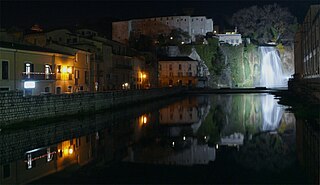
Valle Latina is an Italian geographical and historical region that extends from the south of Rome to Cassino, corresponding to the eastern area of ancient Roman Latium.

The Abbey of Saint Scholastica, also known as Subiaco Abbey, is located just outside the town of Subiaco in the Province of Rome, Region of Lazio, Italy; and is still an active Benedictine abbey, territorial abbey, first founded in the 6th century AD by Saint Benedict of Nursia. It was in one of the Subiaco caves that Benedict made his first hermitage. The monastery today gives its name to the Subiaco Congregation, a grouping of monasteries worldwide that makes up part of the Order of Saint Benedict.

Benedetto Bonazzi was a Catholic archbishop and Italian Hellenist.

The papal nobility are the aristocracy of the Holy See, composed of persons holding titles bestowed by the Pope. From the Middle Ages into the nineteenth century, the papacy held direct temporal power in the Papal States, and many titles of papal nobility were derived from fiefs with territorial privileges attached. During this time, the Pope also bestowed ancient civic titles such as patrician. Today, the Pope still exercises authority to grant titles with territorial designations, although these are purely nominal and the privileges enjoyed by the holders pertain to styles of address and heraldry. Additionally, the Pope grants personal and familial titles that carry no territorial designation. Their titles being merely honorific, the modern papal nobility includes descendants of ancient Roman families as well as notable Catholics from many countries. All pontifical noble titles are within the personal gift of the pontiff, and are not recorded in the Official Acts of the Holy See.
Ranulf I was the count of Caiazzo in the Principality of Capua from about 1078. He also brought the formerly Lombard counties of Alife, Telese and Sant'Agata dei Goti and the castles of Airola and Tocco Caudio under his control, dominating the region between Capua and Benevento. He passed this territorial lordship on intact to his heirs, and it remained in their possession until the death of his grandson and namesake, Ranulf II, in 1139.
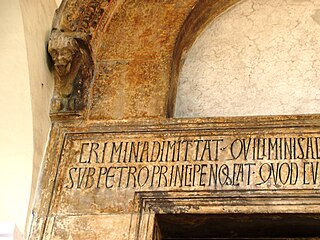
Robert was a south Italian nobleman who ruled the counties of Airola, Alife, Caiazzo, Sant'Agata and Telese from 1088 until his death. He was the regent of Capua in 1090–93, and was effectively independent of any lord after 1105. He was a major patron of churches and abbeys, and also commissioned several books.
The Cesina family is an Italian family of Roman-Lombard origin.

The Valle del Liri is a valley and a geographical region of southern Lazio and part of the larger Latin Valley, located in the province of Frosinone, crossed by the Liri river. The main urban center of the area is Sora.

The Abbey of Leno, or Badia leonense, was an ancient Benedictine monastic complex founded in 758 by the Lombard king Desiderius in the territory of the present-day town of Leno, in the Lower Brescian region. Demolished at the behest of the Venetian Republic in 1783, today only stone fragments of the ancient abbey remain, largely preserved in the Brescian museum of Santa Giulia, while burial mounds were found on site as a result of archaeological excavations held in 2003 by the Superintendence for Archaeological Heritage of Lombardy.
